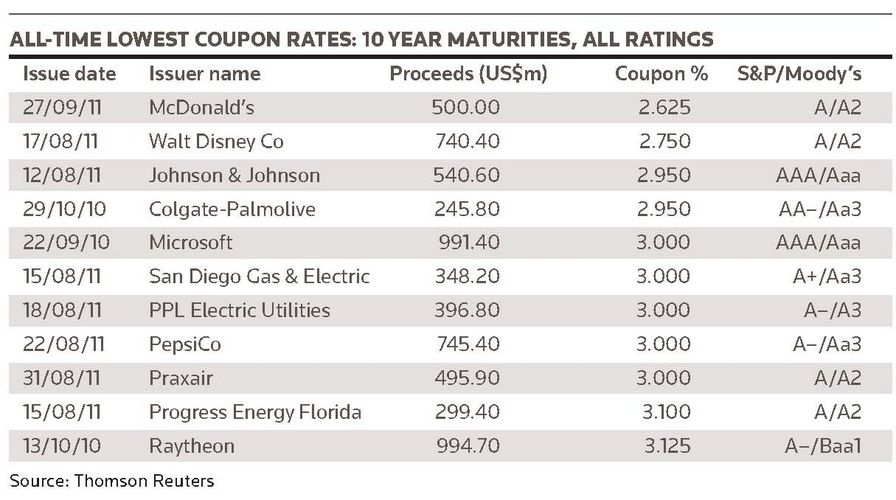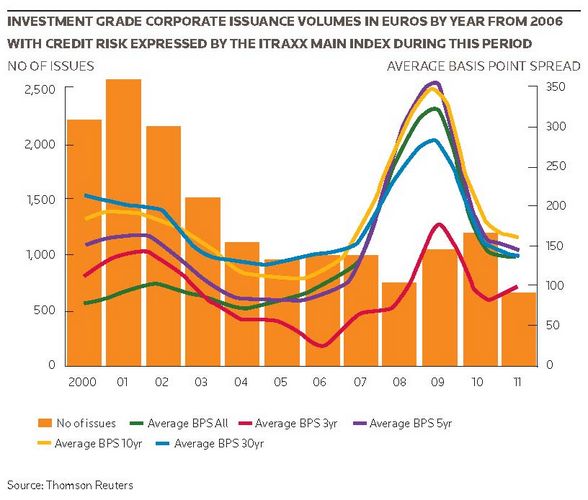Issuers continue to vie for low coupons but this time inflation and rates are on their side, and as concessions grow, investors will be returning to the market.
On the surface, the differences between the US investment-grade dollar bond market this year and last year seem trivial. But to dig deeper is to see two very different capital markets. For issuers and investors, the motivations are the same, but results are not.
Somewhat inconceivably, this year the cost of capital in the bond market is generally cheaper and the returns on investment are growing.
Total volume as of mid-September is just more than US$603bn, only about US$18bn shy of the same period last year. And once again, like last year, household names, Disney, Microsoft and Colgate-Palmolive, for example, are drawing the most attention from investors. And perhaps the greatest similarity between 2010 and 2011 is that the dollar bond market continues to be the most active and amenable capital market in the world.
However, the likeness, for the most part, ends there. This January, for example, saw the rebirth of a market for floating-rate notes which even optimists left for dead after the credit crisis and after banks, the most active FRN issuers, retrenched and curtailed historically abundant financing needs. Though the floater market tailed off a little near mid-year, when rates expectations shifted, volumes so far are several times greater than last year.
In addition, Yankee issuers, particularly European financials, which drove so much of last year’s volumes, have hardly been able to find an audience in the US this year. There are some exceptions, such as the relative successes tallied by Daimler Finance and France Telecom in September, but the eurozone crisis has forced US investors to think twice before stashing away another European name in their portfolio.
Perhaps the biggest difference, however, is one of quantity and not quality. One constant has been low coupons. But this year, aided by even lower Treasury yields, and no real signs that they will rebound, issuers are taking money out of the bond market more inexpensively than ever before. Last year, borrowing was cheap; this year it is measurably cheaper, and industrial corporations are taking advantage of the situation.
The dollar bond market continues to be the most active and amenable capital market in the world
What’s more, they’ve had no real sense of urgency. They can pick and choose when to price new bonds and still get impressive rates: the reigning sentiment has been that great borrowing conditions will be here for a while.
“In the primary markets, the supply doesn’t feel forced,” said Justin D’Ercole, managing director and head of Americas investment-grade debt syndicate at Barclays Capital. “It felt forced for such a long period of time – really for 18 months during the crisis – and it never feels forced now.”
Mickey Mouse and Mc Donald’s break records
While issuers are able to take their time, they are also racking up some remarkable achievements.
McDonald’s Corp stepped in with a 10.25-year late last month which grabbed the top spot in the Thomson Reuters/IFR 10-year low coupon table, ousting previous record holder Walt Disney Company.
McDonald’s hit the market with a US$500m SEC-registered 10.25-year notes offering due January 15 2022.The deal was whispered in the Treasuries +90bp area, but that was quickly whittled down 10bp to Treasuries plus 80bp area official guidance. Ultimately the trade priced at T+78bp (2.625% at 99.588 to yield 2.784%).
Previous record holder Disney hit the top in five, ten and 30-years with its August 17 trade. In the 10-years, the Disney record was 2.75%. The market was ripe with possibility on August 17 when the A2/A/A rated Mickey Mouse purveyor went out to investors. Treasury yields all that week had been coming close to all-time lows. The benchmark 10-year Treasury yield, for example, fell below 2.00% and close to the 1.95% all-time low set in 1941.
What’s drawn issuers to market this year is not necessarily a strong need for cash. The main allure was the ultra-low coupon rates.
“A lot of issuers that have come to market don’t need the cash, but they’re still printing deals,” a DCM banker said. “They’re printing on days when things feel really strong and they’re focused on coupons.”
One banker in August described the conditions as almost ideal. “Credit spreads on highly coveted names like Walt Disney are back at or close to their tights of the year; we’ve hit new lows across the Treasury curve; new issue concessions have abated; and there is a cash-rich investor base,” said Jonathan Fine, managing director and head of investment-grade debt syndicate in the Americas at Goldman Sachs. “When you have a confluence of these events, issuers are going to break some records.”
Disney printed a US$750m offering of five-year notes with a 1.35% coupon at 99.206 to yield Treasuries plus 60bp. The coupon bests the 1.375% record held by Colgate-Palmolive since October 29 2010. The US$750m 10-year finished with a 2.75% coupon at 98.717 to yield plus 72bp, beating the 2.95% coupon achieved by Johnson & Johnson on August 12 2010 and matched by Colgate in October that year. (See chart.)
Meanwhile, Disney’s US$350m 30-year tranche printed with a 4.375% coupon at 99.01 to yield Treasuries plus 87.5bp. J&J also set the previous 30-year record of 4.50% on August 12 2010. A handful of other issuers tied with that level soon thereafter, including Microsoft, San Diego Gas & Electric and Southern California Edison. Most recently, Southwestern Public Service Co priced a 4.50% long bond on August 3 2011.
Inflation magnifies low coupons
Issuers were able to borrow on the very cheap last year, too. But, this time around, the difference is inflation. As inflation expectations increase, it makes real borrowing costs for issuers that much cheaper. Treasurers generally subtract inflation expectations from borrowing cost to arrive at real yield, and that meant, at current rates, money was virtually free, bankers said.
“The big difference [from last year] would be that real yields are now at zero,” D’Ercole said. “If you think about the relative attractiveness of borrowing at a low coupon, when inflation expectations are extremely low – 50bp or 1% over some extended period of time – then 2.50% looks good. But it doesn’t look as good as if 10-year notes are at 2% and inflation expectations are at 2% over 10 years. Then you’re borrowing at zero real yields. So if anything, it has become better.”
In the NIC of time
This trend, if continued unabated, would have spelt near doom for investors, had not the market recently started to pay investors a little extra. New issue concessions have returned, much to the pleasure of portfolio managers.
While investors had been buying well regarded credits most of the year, they were not necessarily getting much in return above Treasury rates or secondary corporate yields. That was great for the likes of Disney, which only had to pay 2.75% for 10-year in August this year versus the 5.50% it paid on a 10-year priced in 2009 (on a US$750m tranche over a decade that’s a US$137.5m difference).
But for the most part, Disney’s savings were their investors’ loss.
However, in the middle to late third quarter, things started to change in investors’ favour. Substantial and satisfying new issue concessions have begun to surface. What has been a seller’s market for so long, is changing into more of a buyer’s market, if only slowly. On more and more deals investors have called the shots and it’s not uncommon to see premiums of 30bp or more, levels unheard of in the first half of the year, when NICs were often flat or in the single digits.
Towards the end of the third quarter, the market is nearly as good for investors as it is for issuers. Treasury rates are so low that corporations are able to lock in low all-in cost of debt while still providing concessions for their investor base. At present, a deal can have a significant premium to outstanding notes, yet still be the issuer’s lowest ever coupon.
Investors are not only getting the upper hand on price. If a deal is not structured the way they want, they’re asking for changes and getting them made. On September 15, investors forced Exelis, a future spin-off from ITT Corp, to rein in maturities. A Triple B deal that launched as a US$650m offering of 10s and 30s finished up as print of fives and 10s. It isn’t typical for such substantive changes to be made to high-grade deals during the marketing stage.
Still, corporate executives or bankers aren’t complaining.
“Simply the notion of being able to borrow at a lower real yield is significant. Ultimately, that’s what really matters,” Barclays’ D’Ercole said. “If you can borrow 1% but in a deflationary environment, 1% feels awful. And if you can borrow at 1% and inflation’s expected to be 2% or 3%, it’s a fantastic opportunity.”
Click here to see the Digital Edition of this report.

